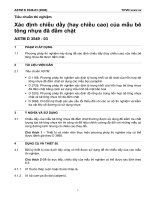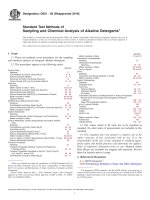Astm d 173 d 173m 03 (2011)e1
Bạn đang xem bản rút gọn của tài liệu. Xem và tải ngay bản đầy đủ của tài liệu tại đây (64.25 KB, 2 trang )
Designation: D173/D173M − 03 (Reapproved 2011)´1
Standard Specification for
Bitumen-Saturated Cotton Fabrics Used in Roofing and
Waterproofing1
This standard is issued under the fixed designation D173/D173M; the number immediately following the designation indicates the year
of original adoption or, in the case of revision, the year of last revision. A number in parentheses indicates the year of last reapproval.
A superscript epsilon (´) indicates an editorial change since the last revision or reapproval.
This standard has been approved for use by agencies of the Department of Defense.
This standard replaces Federal Specification SS-C-450.
´1 NOTE—Units information was editorially corrected in January 2012.
D449 Specification for Asphalt Used in Dampproofing and
Waterproofing
D450 Specification for Coal-Tar Pitch Used in Roofing,
Dampproofing, and Waterproofing
D1079 Terminology Relating to Roofing and Waterproofing
D3775 Test Method for Warp (End) and Filling (Pick) Count
of Woven Fabrics
1. Scope
1.1 This specification covers woven cotton fabrics saturated
with either asphalt or coal-tar pitch intended to be used with
asphalts conforming to Specifications D312 or D449, coal-tar
pitches conforming to Specification D450, or appropriate
solvent bearing bituminous materials in the construction of
roofing and waterproofing systems.
1.1.1 Asphalt-saturated cotton fabric shall be used with
asphalt base plying cement; typical ones are mopping asphalts
conforming to Specifications D312 or D449 or appropriate
solvent bearing asphaltic compounds.
1.1.2 Coal-tar-saturated cotton fabric shall be used with
coal-tar based plying cements; a typical one is coal-tar pitch
conforming to Specification D450 or appropriate solvent bearing coal-tar compounds.
3. Terminology
3.1 Definitions—For definitions of terms used in this specification, refer to Terminology D1079.
4. Materials and Manufacture
4.1 In the process of manufacture, the dry cotton fabric shall
be thoroughly and uniformly saturated with bitumen. This shall
be accomplished by passing the fabric through the saturant or
by spraying with saturant, calendering in the presence of heat,
and then cooling before winding on a core.
1.2 The values stated in either SI units or inch-pound units
are to be regarded separately as standard. The values stated in
each system may not be exact equivalents; therefore, each
system shall be used independently of the other. Combining
values from the two systems may result in non-conformance
with the standard.
4.2 If fabric with a selvage is used, the selvage shall not be
more than 16 mm [5⁄8 in.] wide.
4.3 The fabric shall be woven entirely from cotton fibers,
but customary sizing materials not exceeding 8 % by weight of
the moisture-free cotton shall be permitted to be used.
2. Referenced Documents
2.1 ASTM Standards:2
D146 Test Methods for Sampling and Testing BitumenSaturated Felts and Woven Fabrics for Roofing and
Waterproofing
D312 Specification for Asphalt Used in Roofing
5. Physical Properties
5.1 The material shall conform to the physical requirements
prescribed in Table 1 and the dimensions and masses prescribed in Table 2.
5.2 The finished product shall not crack nor be so sticky as
to cause tearing or other damage upon being unrolled at
temperatures between 10 and 60°C [50 and 140°F].
1
This specification is under the jurisdiction of ASTM Committee D08 on
Roofing and Waterproofing and is the direct responsibility of Subcommittee D08.04
on Felts, Fabrics and Bituminous Sheet Materials.
Current edition approved Nov. 1, 2011. Published January 2012. Originally
approved in 1923. Last previous edition approved in 2003 as D173 – 03. DOI:
10.1520/D0173_D0173M-03R11E01.
2
For referenced ASTM standards, visit the ASTM website, www.astm.org, or
contact ASTM Customer Service at For Annual Book of ASTM
Standards volume information, refer to the standard’s Document Summary page on
the ASTM website.
6. Workmanship, Finish, and Appearance
6.1 The meshes of the fabric shall not be completely closed
or sealed by the process of saturation. There shall be sufficient
porosity maintained to allow successive moppings of the
plying cement to seep through.
Copyright © ASTM International, 100 Barr Harbor Drive, PO Box C700, West Conshohocken, PA 19428-2959. United States
1
D173/D173M − 03 (2011)´1
TABLE 1 Physical Properties of Saturated Cotton Fabrics
Property
Breaking loadA at 21.1°C [70°F], both warp and fill
directions, min, kN/m [lbf/in.]
Pliability at 0°C [32°F]
7.2 Determine the pliability of the saturated fabric at 0°C
[32°F] by bending over a 1.6-mm [1⁄16-in.] diameter mandrel
through an arc of 180° in one direction and then through 360°
in the opposite direction.
7.3 Determine the thread count in accordance with Test
Method D3775.
Requirement
8.76 [50]
no cracking
A
Committee D08 recognizes the advisability of including a requirement relative
to the percentage elongation before rupture, but in the absence of any reliable test
method, such requirement cannot be stated at the present time.
8. Inspection
8.1 Inspection—Inspection shall be in accordance with the
requirements of this specification.
8.2 Inspection Alternatives—Alternative inspection requirements shall be determined by and agreed upon between the
purchaser and the supplier.
TABLE 2 Dimensions and Masses of Saturated Cotton Fabrics
min
Width of roll, mm [in.]
Gross mass per roll, kg [lb]
Mass of mandrel and wrapping
material, kg [lb]
Mass of detached comminuted
surfacing, g/m2 [lb/100 ft2 ]
Net mass of saturated fabric, avg,
g/m 2 [oz/yd2 ]
Thread count per 25.4 mm [1 in.]
Warp
Filling
Moisture, at point of manufacture,
max, % A
Mass of desaturated, moisture-free
fabric, avg, g/m2 [oz/yd2 ]
Ash (based on mass of
desaturated fabric), %
Mass of saturant
max
762 [30]
15.9 [35]
...
965 [38]
36.3 [80]
1.13 [2.5]
...
49 [1.0]
340 [10]
...
10.2 [26]
9.4 [24]
...
12.6 [32]
12.6 [32]
6.0
119 [31⁄2 ]
...
...
2.0
1.6 × (mass of
desaturated,
moisture-free
fabric in the same
area)
...
9. Rejection and Resubmittal
9.1 Failure to Conform—Failure to conform to any of the
requirements as stated in this specification constitutes grounds
for rejection.
9.2 Rejection Redress—The supplier shall have the right to
inspect the rejected materials. The supplier and the purchaser
shall agree to the quantity of rolls deemed unacceptable. The
supplier shall then have the right to submit the same number of
new rolls as replacement.
6.4 The finished material shall be free of visible external
defects such as ragged or untrue edges, breaks, rents, or cracks.
10. Packaging and Package Marking
10.1 Unless otherwise agreed upon between the supplier
and purchaser, each product package shall be plainly marked
with the supplier’s name, the product brand, the ASTM
designation, and type of bitumen if not evident in the label
name of the product.
10.2 The rolls shall be securely wrapped or banded in a
manner that completely encircles the roll and will prevent
slipping or unrolling.
10.3 No roll shall contain more than two pieces, and no
more than 3 % of the rolls in any lot shall contain two pieces.
If a roll contains a manufacturing splice, the splice shall be
clearly marked.
10.4 The rolls shall be wound on mandrels or rigid hollow
fiber cylinders not less than 50 mm [2 in.] in diameter,
extending not more than 100 mm [4 in.] beyond the end of the
rolls.
7. Sampling and Test Methods
11. Keywords
7.1 Sample the material and determine compliance with
these specifications in accordance with Test Methods D146.
11.1 bitumen-saturated; roofing and waterproofing; woven
cotton fabric
16 [5⁄8 ]
Selvage, mm [in.]
A
At time of manufacture, products with higher moisture content at time of
installation may cause hot materials to foam, creating interply voids that may result
in blisters.
6.2 The surface of the fabric shall not be coated or covered
with talc or other substances that would tend to interfere with
adhesion between the fabric and the plying cement. The use of
silica or wood flour is permissible.
6.3 The surface shall be uniformly smooth and free of
irregularities, folds, or knots.
ASTM International takes no position respecting the validity of any patent rights asserted in connection with any item mentioned
in this standard. Users of this standard are expressly advised that determination of the validity of any such patent rights, and the risk
of infringement of such rights, are entirely their own responsibility.
This standard is subject to revision at any time by the responsible technical committee and must be reviewed every five years and
if not revised, either reapproved or withdrawn. Your comments are invited either for revision of this standard or for additional standards
and should be addressed to ASTM International Headquarters. Your comments will receive careful consideration at a meeting of the
responsible technical committee, which you may attend. If you feel that your comments have not received a fair hearing you should
make your views known to the ASTM Committee on Standards, at the address shown below.
This standard is copyrighted by ASTM International, 100 Barr Harbor Drive, PO Box C700, West Conshohocken, PA 19428-2959,
United States. Individual reprints (single or multiple copies) of this standard may be obtained by contacting ASTM at the above
address or at 610-832-9585 (phone), 610-832-9555 (fax), or (e-mail); or through the ASTM website
(www.astm.org). Permission rights to photocopy the standard may also be secured from the ASTM website (www.astm.org/
COPYRIGHT/).
2









